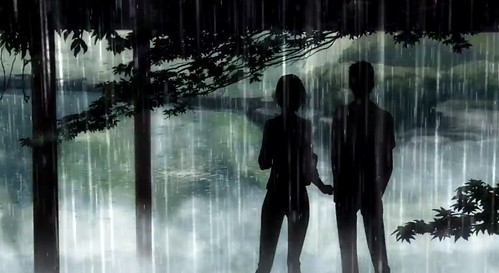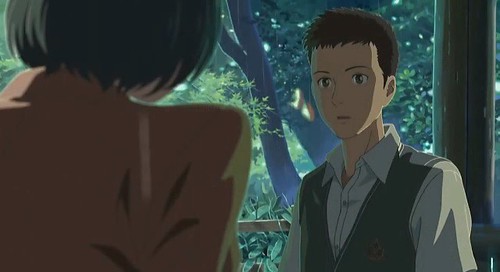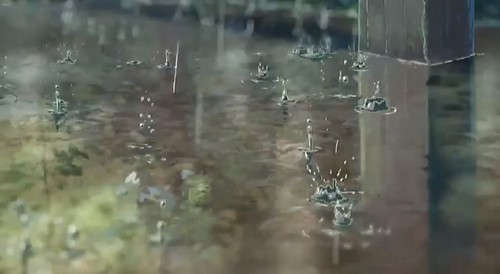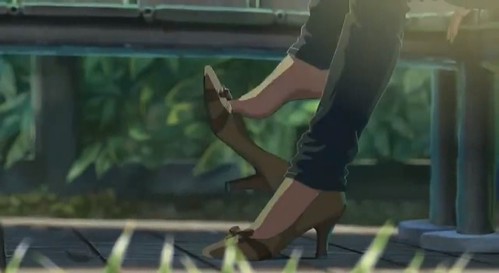Tilling The Garden of Words
Dissecting the visual acuity of Makoto Shinkai
 Choosing a favorite movie is like choosing a favorite poem — almost impossible; different titles are favorites for certain moods. If forced to, I’ll always default to “l(a)” by e. e. cummings, a poem most students encounter in high school and take to be the bane of their poetic education. “l(a)” consists of, in its entirety, 4 words: the parenthetical phrase “a leaf falls” cradled within the word “loneliness.” There is an unbelievable amount of information to be extracted from such a tiny poem, but suffice it to say that the phrase, the image of one leaf falling, epitomizes the word which hosts it. This is exactly what I love about Makoto Shinkai’s latest 46-minute movie, The Garden of Words, which portrays communication, flirtation, and isolation almost entirely through its stunning imagery and masterful art direction.
Choosing a favorite movie is like choosing a favorite poem — almost impossible; different titles are favorites for certain moods. If forced to, I’ll always default to “l(a)” by e. e. cummings, a poem most students encounter in high school and take to be the bane of their poetic education. “l(a)” consists of, in its entirety, 4 words: the parenthetical phrase “a leaf falls” cradled within the word “loneliness.” There is an unbelievable amount of information to be extracted from such a tiny poem, but suffice it to say that the phrase, the image of one leaf falling, epitomizes the word which hosts it. This is exactly what I love about Makoto Shinkai’s latest 46-minute movie, The Garden of Words, which portrays communication, flirtation, and isolation almost entirely through its stunning imagery and masterful art direction.
 At its heart, The Garden of Words (CoMix Wave Films) is the story of a high school boy (Takao) who unknowingly and very gradually falls in love with an older woman (Yukino) he meets by chance in Shinjuku Gyoen National Park. Takao’s a bit of an oddity, a throwback: a very mature-for-his-age youth with a dated but passionate artistic penchant for shoemaking. Yukino is initially a mystery aside from her immature tendency to shirk responsibility (work) in favor of drinking beer and eating chocolate and her love of classic literature — specifically poetry. While the magic lies in watching this movie happen, the analysis of select images from this movie may contain plot spoilers. This is not a review, this is an analysis. If you’ve watched the movie already, read on and enjoy the creaking of my brain gears! If you’ve yet to see the movie, buy or rent it, watch it, and then come back and read the following:
At its heart, The Garden of Words (CoMix Wave Films) is the story of a high school boy (Takao) who unknowingly and very gradually falls in love with an older woman (Yukino) he meets by chance in Shinjuku Gyoen National Park. Takao’s a bit of an oddity, a throwback: a very mature-for-his-age youth with a dated but passionate artistic penchant for shoemaking. Yukino is initially a mystery aside from her immature tendency to shirk responsibility (work) in favor of drinking beer and eating chocolate and her love of classic literature — specifically poetry. While the magic lies in watching this movie happen, the analysis of select images from this movie may contain plot spoilers. This is not a review, this is an analysis. If you’ve watched the movie already, read on and enjoy the creaking of my brain gears! If you’ve yet to see the movie, buy or rent it, watch it, and then come back and read the following:
 The opening scene is of a branch of a tree dipping the tips of but its foremost extended leaves very softly into a pond, just barely breaking the surface. This image repeats several times, each for a specific effect. At first, this gentle interaction just seems like a lovely, almost photorealistic shot of nature. What it comes to represent, however, is the tentative touch of infatuation and experimentation. Later, as Takao and Yukino become more familiar with each other, the above image repeats, but the branch hangs heavier and dips faster from higher winds and the weight of rain. Lastly, the same deciduous branch is shown in winter, bare, unweighted, and not touching the pond at all. Although I previously described a branch, which could symbolize either Takao or Yukino, as being heavy with rain, realize that rain is what originally brings these two strangers together and is thus a positive image, one of hope, one of escape.
The opening scene is of a branch of a tree dipping the tips of but its foremost extended leaves very softly into a pond, just barely breaking the surface. This image repeats several times, each for a specific effect. At first, this gentle interaction just seems like a lovely, almost photorealistic shot of nature. What it comes to represent, however, is the tentative touch of infatuation and experimentation. Later, as Takao and Yukino become more familiar with each other, the above image repeats, but the branch hangs heavier and dips faster from higher winds and the weight of rain. Lastly, the same deciduous branch is shown in winter, bare, unweighted, and not touching the pond at all. Although I previously described a branch, which could symbolize either Takao or Yukino, as being heavy with rain, realize that rain is what originally brings these two strangers together and is thus a positive image, one of hope, one of escape.
 On rainy days, Takao likes to skip first period in favor of dawdling in the park while sketching shoe ideas. Each rainy day brings Takao to the park and reunites him with the mysterious Yukino. Rain itself is therefore meant to be seen as a positive image, as it represents opportunity, whereas most people harbor the opposite opinion and see it as an oppressive thing. Even this small detail can be seen in the faces of Takao and Yukino, which seem brighter, more animated, when they awake to droplets streaking down their respective windows. Aside from cordialities, not much is ever said audibly between Takao and Yukino during their initial run-ins. Everything expressed about how these two are feeling is implied through visuals.
On rainy days, Takao likes to skip first period in favor of dawdling in the park while sketching shoe ideas. Each rainy day brings Takao to the park and reunites him with the mysterious Yukino. Rain itself is therefore meant to be seen as a positive image, as it represents opportunity, whereas most people harbor the opposite opinion and see it as an oppressive thing. Even this small detail can be seen in the faces of Takao and Yukino, which seem brighter, more animated, when they awake to droplets streaking down their respective windows. Aside from cordialities, not much is ever said audibly between Takao and Yukino during their initial run-ins. Everything expressed about how these two are feeling is implied through visuals.
 Case in point: Yukino dangling her shoe from her toes askew from Takao. It could be the result of boredom – the two are sitting in complete silence, but this act seems more like an implemented distraction. Yukino is, after all, usually shown reading a book or perfectly happy staring off into the clouds. So no, this is not boredom; this is experimentation. Yukino has a beer or two in her, and to interact with this young man seems like it would be fun! So this exposure of something normally covered, the heel and sole of her foot, is meant as a playful, sensual lure. Not as daring due to either his artisan’s tunnel vision or romantic inexperience, Takao exudes an innocence that seems to bait Yukino. It’s the tease of conquest – to remove his innocence. Submitted for your approval, the best depiction of a first sexual encounter ever in anime:
Case in point: Yukino dangling her shoe from her toes askew from Takao. It could be the result of boredom – the two are sitting in complete silence, but this act seems more like an implemented distraction. Yukino is, after all, usually shown reading a book or perfectly happy staring off into the clouds. So no, this is not boredom; this is experimentation. Yukino has a beer or two in her, and to interact with this young man seems like it would be fun! So this exposure of something normally covered, the heel and sole of her foot, is meant as a playful, sensual lure. Not as daring due to either his artisan’s tunnel vision or romantic inexperience, Takao exudes an innocence that seems to bait Yukino. It’s the tease of conquest – to remove his innocence. Submitted for your approval, the best depiction of a first sexual encounter ever in anime:
Takao’s not a particularly shy kid, but he is not confident about the art he produces. This he hides in a notebook which he lets no-one see. Even though Yukino knows of his occupational passion, she’s locked out of Takao’s innermost essence. Oh what a tease that is! So after Takao finally and innocently divulges the fact that he’s designing a woman’s shoe but has no model, Yukino slowly takes off one of her shoes and pushes that bare foot forward (taking the first step, if you’ll pardon the pun). There’s hesitant first contact; Takao, almost mesmerized by Yukino’s exposed flesh, reaches forth and touches her foot with virginal delicacy.  While Takao feels about, lifting and moving her foot as needed for his measurements, Yukino makes bolder moves one would expect of a more experienced partner. The way she stands up (gets on top), moves her leg forward just the slightest bit with a hint of playful guidance and aggression, and the way she looks at Takao while he’s almost totally obsessed with tracing her features all speak to a first sexual encounter.
While Takao feels about, lifting and moving her foot as needed for his measurements, Yukino makes bolder moves one would expect of a more experienced partner. The way she stands up (gets on top), moves her leg forward just the slightest bit with a hint of playful guidance and aggression, and the way she looks at Takao while he’s almost totally obsessed with tracing her features all speak to a first sexual encounter.
After the apex of this metaphorical romance comes the inevitable estrangement. You can read this as the distance created due to the crossing of lines, but really it’s just that the rainy season ends and consequently dries up any casual excuse for these two to meet at their dedicated gazebo. Longing grows within both parties, and the feeling of isolation is shown particularly through Takao … with a little (unintentional) help from e. e. cummings.
 While feeling particularly isolated and lonesome, Takao walks to the park one day and faces the gazebo where he usually met Yukino. But the weather’s clear and sunny (remember, sunny and bright is antagonistic in this movie); Yukino’s not there. I’d love to say this is on purpose, or maybe it’s just because Shinkai shares some of the same brilliance and sense of loneliness as cummings, but there’s a short and steady view of Takao looking at that gazebo while a single leaf falls. This shot, held from the leaf’s entrance into the frame until its grounding, conveys everything Takao’s feeling — the loneliness intimated via the falling leaf is further compounded by the empty gazebo; the weather is literally illuminating the hollowness therein. But the visuals don’t only pertain to inter- and intra-character communication. They also enhance character framing.
While feeling particularly isolated and lonesome, Takao walks to the park one day and faces the gazebo where he usually met Yukino. But the weather’s clear and sunny (remember, sunny and bright is antagonistic in this movie); Yukino’s not there. I’d love to say this is on purpose, or maybe it’s just because Shinkai shares some of the same brilliance and sense of loneliness as cummings, but there’s a short and steady view of Takao looking at that gazebo while a single leaf falls. This shot, held from the leaf’s entrance into the frame until its grounding, conveys everything Takao’s feeling — the loneliness intimated via the falling leaf is further compounded by the empty gazebo; the weather is literally illuminating the hollowness therein. But the visuals don’t only pertain to inter- and intra-character communication. They also enhance character framing.
I’ll leave you the introductory shot of Takao, which shows him, like a rock in a river, as an impediment to the flow of commuters exiting a train on their way to work or school. This shot establishes that he’s not a traditional rebel — that he doesn’t so much go against the flow as he refuses to go along with it. This image tastefully complements his shoemaker’s path without resorting to dressing him up in old-timey garb, doing something likewise silly to the character design, or similarly having to resort to exposition. In fact, the only thing about his dress that’s off is a pair of shoes he always wears that he’s made for himself — a symbol of strength through self-empowerment.
 There are so many visuals to pick apart throughout The Garden of Words that I cannot not possibly examine them all here — I’m already WAY over word count and feel I’ve not done a single scene justice. But hopefully this analysis has offered a few ways to look at things which might not have been obvious upon first viewing. Stunning to watch the first time through, this movie offers up a lot of blatant imagery. Upon second viewing, however, there are a ton of images that subtly foreshadow the directions of relationships, the nature of characters, and even the relationships of the characters with the world into which Shinkai has written them. I don’t only recommend this film, I recommend multiple viewings … and a BIG box of tissues.
There are so many visuals to pick apart throughout The Garden of Words that I cannot not possibly examine them all here — I’m already WAY over word count and feel I’ve not done a single scene justice. But hopefully this analysis has offered a few ways to look at things which might not have been obvious upon first viewing. Stunning to watch the first time through, this movie offers up a lot of blatant imagery. Upon second viewing, however, there are a ton of images that subtly foreshadow the directions of relationships, the nature of characters, and even the relationships of the characters with the world into which Shinkai has written them. I don’t only recommend this film, I recommend multiple viewings … and a BIG box of tissues.
